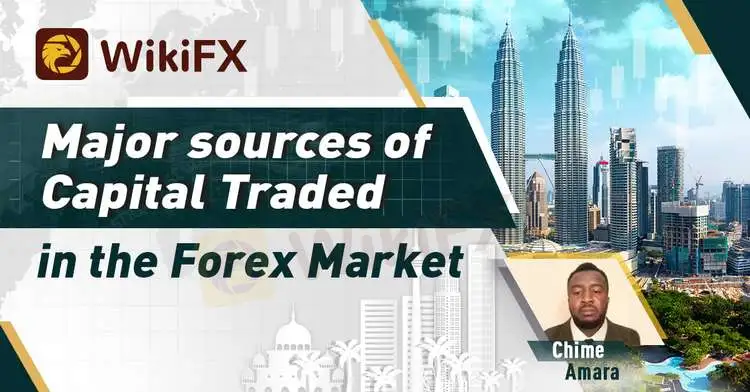Major sources of Capital Traded in the Forex Market
Abstract:Very often many traders get curious when they hear that the forex market has the largest amount of capital investment in the world with over 6.2 Trillion dollars invested and roughly 1.5 Trillion dollars traded daily. Some pause to argue where these large capitals come from. To this end, we have discussed extensively in the article, the major sources of the Capital traded in the forex market today.

By: Chime Amara

Major sources of Capital traded in the forex market.
There are mainly six major contributors of the capital traded in the forex market today. These players encompass both the big banks, institutions, government, hedge fund and retail traders. Below is the list of these players in the forex market today:
· Central Banks: The Central Banks are the liquidity providers in the forex market. They set the rate at which various currencies could be exchanged. The reason why they are called liquidity providers owes to the fact that they supply the commercial banks with the foreign currencies to be exchanged at the counter (OTC).
· Commercial Banks: Commercial banks are no doubt the biggest players in the forex market today. They contribute over 70% of the capital traded in the forex market. Their positions move the market more than any other. Hence, most retail traders tend to study the direction taken by these banks to guide them in making their own decisions. The major commercial banks are in the industry are: Citi Bank 6.9%, JP Morgan 7.9%, UBS 6.2%, Barclays Bank 5.7%, Deutsche Bank 7.2%, BAML 4.2%, Goldman Sachs 8.3%, HSBC 7.3%, Morgan Stanley 8.2%, XTX Markets 5.1%, etc.
· Government: Government bodies are the third significant players in the forex market today. They contribute over 8% of the capital traded in the forex market. They are often long-term investors. Often they preserved the country's savings in different currencies to hedge against inflations.
· Hedge Fund: This is made up of a large sum of money contributed by individuals and given to an expert to trade on their behalf and deliver profits to the owners. The total amount contributed by these wealthy individuals is often so large; measuring over 5% of the capital traded in the forex market today.
· Institutions: Many big firms are known to participate in the forex market. Through forex trading, various institutions can beat inflations and sustain their business. Also, multi-national corporations can maintain their branches in different countries through forex trading. Over 3% of the capital traded in the forex market today comes from these institutions.
· Retail/Individual Traders: Individual traders constitute the largest population of participants in the forex market today. They provide the least capital in the market despite having the largest number. Often only 1% of the capital traded in the forex market today comes from the individual. The reason is understandable as virtually every trader leaves 90% of their capital with the commercial banks while investing with the rest. The bank in return now has large capital at its disposal to participate in the forex market.

Related broker






Read more

WikiFX Elites Club Officially Established: Create Healthy Investment Ecosystem
WikiFX has officially announced the establishment of the WikiFX Elites Club—an exclusive platform rooted in the WikiFX community, aimed at promoting information transparency and healthy development within the forex industry. The club brings together professional and influential practitioners from around the world, dedicated to building a more open, transparent, and vibrant forex investment ecosystem.

Gold Has Really Skyrocketed—Could Trump Continue to Fuel the Surge?
Trump's latest move to impose tariffs has caused turbulence in global markets, with gold surpassing the $2900 mark. However, with Trump further pressuring Iran and trade partners, how long will gold continue to rise and how high will it go?

Will Crude Oil Prices Choose a Direction Next Week?
Oil prices have stabilized due to several factors, particularly after an industry report on Tuesday showed a significant increase in U.S. oil inventories. So, what will be the trend for oil prices in the coming week?

Is Copy Trading as Safe as It Seems?
Many traders want to make money without spending too much time learning. Copy trading seems like an easy way to do this. It allows you to copy the trades of experienced traders. You follow their moves, and your account mirrors their actions. It sounds simple. But is it really safe?
WikiFX Broker
Latest News
TD Bank to Sell $14.9 Billion Schwab Stake, Repurchase Shares
Warning Against Agra Markets: Stay Cautious!
Trump tariffs: Retaliate or negotiate - what will US partners do next?
Hacker Who Breached SEC Account and Falsely Announced Bitcoin ETF Approval Faces Trial
Oil Prices Fluctuate as Iran and Trump Clash!
Best Regulated Forex Brokers Offering Daily Trading Signals
VPFX Secures UAE SCA License, Expands FX and CFDs Services
RBI New Initiative: ‘bank.in’ to Protect You from Fraud
MultiBank Group Launches UAE CFD Shares on MultiBank-Plus App and MT5
TradingHub Expands in Australia with Bronwyn Hill as Senior Relationship Manager
Rate Calc

